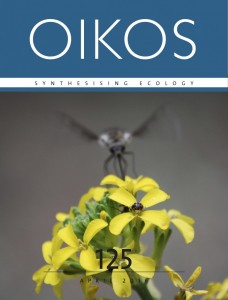Our paper “The temporal dimension in individual-based plant pollination networks” has been published in Oikos. In this paper we present the temporal changes occurring in a pollination network established between individuals of the extremely generalist herb Erysimum mediohispanicum (Brassicaceae). We explored this dynamics in a controlled population during two flowering seasons, using metrics (modularity, clustering, and core-periphery structure) related to properties influencing the functioning of networks, such as cohesion, transitivity, and centralization.
You can find more information in this post in the Oikos’ Blog.

Abstract
The pollination success of animal-pollinated plants depends on the temporal coupling between flowering schedules and pollinator availability. Within a population, individual plants exhibiting disparate flowering schedules will be exposed to different pollinators when the latter exhibit temporal turnover. The temporal overlap between individual plants and pollinators will result in a turnover of interactions, which can be analyzed through a network approach. We have explored the temporal dynamics of individual-based plant networks resulting from pairwise similarities in pollinator composition. During two flowering seasons, we surveyed the phenology and pollinator fauna of the individual plants from a population of Erysimum mediohispanicum (Brassicaceae). We analyzed the topology of these networks by means of their modularity, clustering, and core–periphery structure. These metrics are related to network functional properties such as cohesion, transitivity and centralization respectively. Afterwards, we analyzed the influence of each pollinator functional group on network topology. We found that network topology varied widely over time as a consequence of the differences in plant phenology and the idiosyncratic and contextual effect of pollinators. When integrating all temporary networks, the network became cohesive (non modular), transitive (locally clusterized), and centralized (core–periphery topology). These topologies could entail important consequences for plant reproduction. Our results highlight the importance of considering the entire flowering season and the necessity of making comprehensive temporal sampling when trying to build reliable interaction networks.
